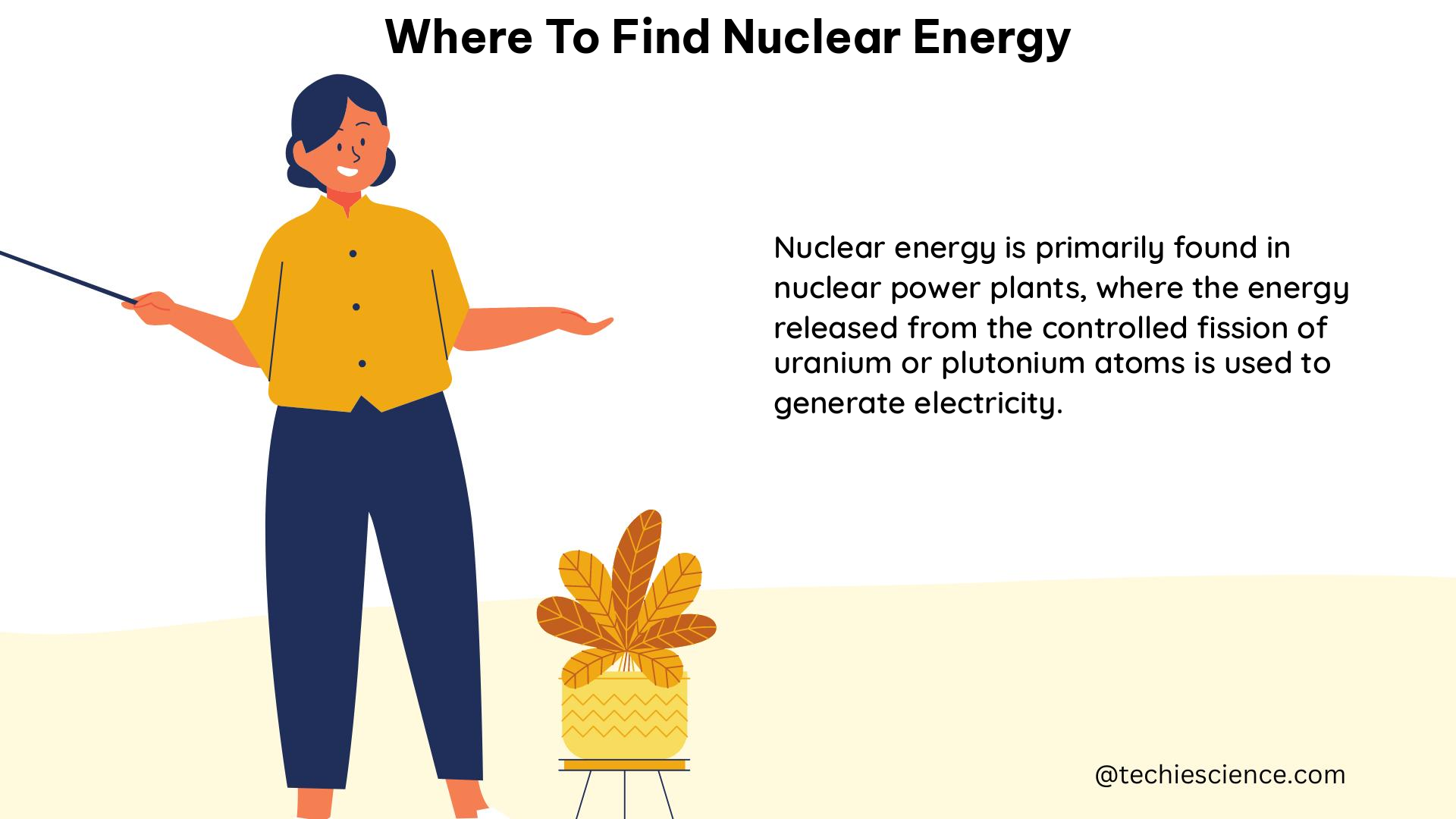Nuclear energy is primarily found in the nucleus of atoms, specifically in the form of uranium or plutonium isotopes. Uranium is the most commonly used fuel in nuclear power plants, with uranium-235 being the isotope of interest due to its ability to sustain a nuclear chain reaction. This comprehensive guide will delve into the technical details and specific locations where nuclear energy can be found, providing a valuable resource for physics students.
Understanding the Nucleus: The Source of Nuclear Energy
The nucleus of an atom is the central core, composed of protons and neutrons, where the vast majority of an atom’s mass is concentrated. This dense region is the source of nuclear energy, as the strong nuclear force that binds the protons and neutrons together can be harnessed to generate electricity through nuclear fission or fusion processes.
The key to understanding where nuclear energy is found lies in the specific isotopes of elements that are capable of sustaining a nuclear chain reaction. The most commonly used isotope for nuclear power generation is uranium-235 (U-235), which has a natural abundance of only 0.7% in natural uranium. The fission of U-235 nuclei is the primary mechanism behind the operation of nuclear power plants.
Uranium-235: The Isotope of Choice
Uranium-235 is the isotope of uranium that is most suitable for nuclear energy production due to its unique properties. The U-235 isotope has a lower binding energy per nucleon compared to the more abundant uranium-238 (U-238) isotope, making it more susceptible to fission when bombarded with neutrons.
The fission of U-235 nuclei releases a significant amount of energy, as well as additional neutrons that can then trigger further fission reactions, creating a self-sustaining chain reaction. This chain reaction is the foundation of nuclear power generation, where the heat released from the fission process is used to generate steam and drive turbines to produce electricity.
Geographical Distribution of Uranium Resources

Uranium, the primary fuel for nuclear power plants, is found in various regions around the world. The distribution of uranium resources is an important factor in determining the global supply and accessibility of nuclear energy.
Top Uranium-Producing Countries
According to the World Nuclear Association, the top five uranium-producing countries as of 2020 are:
- Kazakhstan: 41% of global uranium production
- Canada: 13% of global uranium production
- Australia: 12% of global uranium production
- Namibia: 6% of global uranium production
- Russia: 6% of global uranium production
These countries collectively account for over 75% of the world’s uranium production, making them the primary sources of the essential fuel for nuclear power generation.
Uranium Reserves and Resources
In addition to the current production levels, the global uranium reserves and resources are also crucial in understanding the long-term availability of nuclear energy. The World Nuclear Association estimates the following:
- Identified Uranium Resources: 8.1 million metric tons
- Reasonably Assured Resources (RAR): 5.4 million metric tons
- Inferred Resources: 2.7 million metric tons
These figures indicate that there are substantial uranium resources available globally, which can support the continued operation and expansion of nuclear power plants in the foreseeable future.
Nuclear Power Generation in the United States
The United States plays a significant role in the global nuclear energy landscape, with a substantial number of operational nuclear reactors and a significant contribution to the overall nuclear electricity generation.
U.S. Nuclear Reactor Fleet
According to the U.S. Energy Information Administration, as of 2020, the United States had 93 operable nuclear reactors, with a total net summer electricity generation capacity of 95,516 megawatts (MW).
The largest nuclear power plant in the U.S. is the Palo Verde Nuclear Generating Station, located in Arizona. Palo Verde has a net summer electricity generation capacity of 3,937 MW, making it one of the largest nuclear power plants in the world.
U.S. Nuclear Electricity Generation
In 2020, the total annual net electricity generation from nuclear power plants in the United States was 778,188 million kilowatt-hours (kWh). This accounted for 18.9% of the country’s total annual electricity generation, highlighting the significant contribution of nuclear energy to the U.S. power grid.
The top five nuclear electricity-generating states in the U.S. are:
- Illinois: 105,670 million kWh
- Pennsylvania: 93,651 million kWh
- New Hampshire: 55,524 million kWh
- South Carolina: 55,524 million kWh
- Arizona: 32,089 million kWh
These states are home to some of the largest and most productive nuclear power plants in the country, demonstrating the widespread distribution of nuclear energy resources within the United States.
Global Nuclear Energy Landscape
The global nuclear energy landscape is characterized by the contributions of several key countries, each playing a significant role in the production and utilization of nuclear power.
Top Nuclear Electricity-Generating Countries
According to the World Nuclear Association, the top five nuclear electricity-generating countries in the world as of 2020 were:
- United States: 809 billion kWh
- France: 335 billion kWh
- China: 330 billion kWh
- Russia: 215 billion kWh
- South Korea: 141 billion kWh
These countries account for a significant portion of the world’s total nuclear electricity generation, which was 2,591 billion kWh in 2020.
Nuclear Power Plant Capacity
In addition to the electricity generation, the global nuclear power plant capacity is another important metric to consider. As of 2020, the total installed nuclear power capacity worldwide was 392 gigawatts (GW).
The countries with the largest nuclear power plant capacities are:
- United States: 95.5 GW
- China: 49.9 GW
- France: 61.4 GW
- Russia: 28.5 GW
- South Korea: 23.2 GW
These figures highlight the significant investments and technological advancements made by these countries in the development and deployment of nuclear power infrastructure.
Conclusion
Nuclear energy is a crucial component of the global energy mix, and understanding where it can be found is essential for physics students and researchers. This comprehensive guide has explored the technical details of nuclear energy, the geographical distribution of uranium resources, the nuclear power generation landscape in the United States, and the global nuclear energy landscape.
By delving into the specifics of uranium isotopes, uranium-producing countries, nuclear reactor fleets, and electricity generation data, this guide provides a valuable resource for physics students to deepen their understanding of the complex and multifaceted world of nuclear energy.
References
- U.S. Energy Information Administration. (2021). Nuclear Explained. Retrieved from https://www.eia.gov/energyexplained/nuclear/
- World Nuclear Association. (2021). Supply of Uranium. Retrieved from https://world-nuclear.org/information-library/nuclear-fuel-cycle/uranium-resources/supply-of-uranium.aspx
- Our World in Data. (2020). Nuclear Energy. Retrieved from https://ourworldindata.org/nuclear-energy
- International Atomic Energy Agency. (2021). Power Reactor Information System. Retrieved from https://pris.iaea.org/PRIS/home.aspx
- U.S. Nuclear Regulatory Commission. (2021). Locations of Power Reactors. Retrieved from https://www.nrc.gov/info-finder/reactors/

The lambdageeks.com Core SME Team is a group of experienced subject matter experts from diverse scientific and technical fields including Physics, Chemistry, Technology,Electronics & Electrical Engineering, Automotive, Mechanical Engineering. Our team collaborates to create high-quality, well-researched articles on a wide range of science and technology topics for the lambdageeks.com website.
All Our Senior SME are having more than 7 Years of experience in the respective fields . They are either Working Industry Professionals or assocaited With different Universities. Refer Our Authors Page to get to know About our Core SMEs.